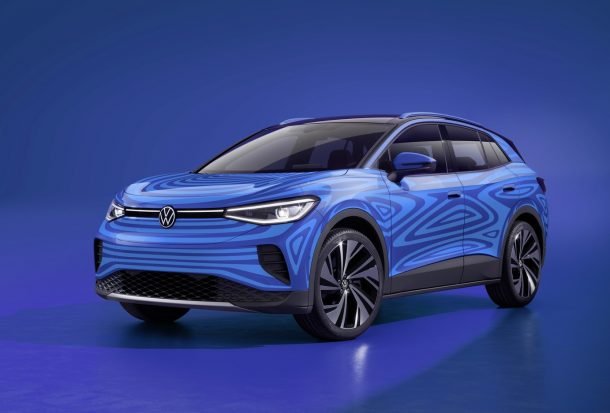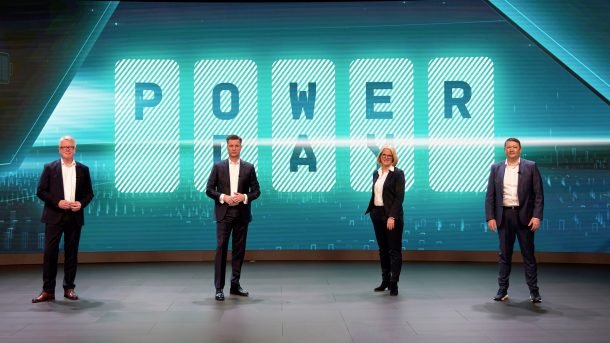<img data-attachment-id="1755530" data-permalink="https://www.thetruthaboutcars.com/2021/03/teutonic-tesla-volkswagen-now-building-gigafactories/volkswagen-power-day-2021/" data-orig-file="https://www.thetruthaboutcars.com/wp-content/uploads/2021/03/DB2021AL00276_medium.jpg" data-orig-size="1795,1010" data-comments-opened="1" data-image-meta="{"aperture":"0","credit":"","camera":"","caption":"","created_timestamp":"0","copyright":"Volkswagen AG","focal_length":"0","iso":"0","shutter_speed":"0","title":"Volkswagen Power Day 2021","orientation":"1"}" data-image-title="Volkswagen Power Day 2021" data-image-description="
VW Group
” data-medium-file=”http://turbosaga.com/wp-content/uploads/2021/03/teutonic-tesla-volkswagen-now-building-gigafactories-2.jpg” data-large-file=”http://turbosaga.com/wp-content/uploads/2021/03/teutonic-tesla-volkswagen-now-building-gigafactories.jpg” class=”aligncenter size-large wp-image-1755530″ src=”http://turbosaga.com/wp-content/uploads/2021/03/teutonic-tesla-volkswagen-now-building-gigafactories.jpg” alt width=”610″ height=”343″ srcset=”http://turbosaga.com/wp-content/uploads/2021/03/teutonic-tesla-volkswagen-now-building-gigafactories.jpg 610w, http://turbosaga.com/wp-content/uploads/2021/03/teutonic-tesla-volkswagen-now-building-gigafactories-1.jpg 75w, http://turbosaga.com/wp-content/uploads/2021/03/teutonic-tesla-volkswagen-now-building-gigafactories-2.jpg 450w, http://turbosaga.com/wp-content/uploads/2021/03/teutonic-tesla-volkswagen-now-building-gigafactories-3.jpg 768w, http://turbosaga.com/wp-content/uploads/2021/03/teutonic-tesla-volkswagen-now-building-gigafactories-4.jpg 120w, http://turbosaga.com/wp-content/uploads/2021/03/teutonic-tesla-volkswagen-now-building-gigafactories-5.jpg 800w” sizes=”(max-width: 610px) 100vw, 610px”>
As much as we’ve criticized American luxury brands for emulating the Germans, we’ve failed to do the same for Volkswagen Group’s pathetic attempts at copying Tesla. That changes with Monday’s announcement that VW will assemble six “gigafactories” in Europe by 2030. Shared on “Power Day” — the company’s bastardized version of Tesla’s Battery Day — the plan is supposed to result in a production capacity of 240 GWh annually when completed and help VW reduce battery costs while also securing access.
It’s not a half-bad plan for a company entirely devoted to electrification, which is probably why Tesla follows a similar model using nearly identical terminology. Though, considering the absolute mess Volkswagen seems to have made of its EV transmission thus far, some might find it difficult to blame the automaker for looking at the competition and breaking out the notepad.
Others will be less sympathetic while acknowledging this is probably VW’s best play if it’s serious about EVs.
Volkswagen is only in this mess for getting caught circumventing emissions by illegal means, specifically software that flubbed the test results of diesel models. While we’re happy to suggest the brand was placed in a difficult situation by being the first automaker to get majorly busted for skirting the nearly impossible to adhere to rules regarding modern diesel emissions, it was still being exposed to the same scrutiny as other manufacturers. But it went the coverup route before confessing and has responded by transmogrifying itself into a beacon of greenness as penance for its eco-crimes. Volkswagen became a “mobility company” overnight in 2016 — born again, so to speak — despite its product lineup showing its status as a relatively traditional automaker, often forcing us to take it at its word.
VW has endeavored to keep up appearances while sprinting full tilt toward widespread electrification. But the fruit of its labor haven’t always panned out. The company has had a terrible time with battery suppliers and most of the EVs delivered thus far aren’t offering the kind of ranges that would make them compelling choices. Digitizing its products has also resulted in software issues that helped stymie the launches of numerous vehicles. In some cases, it even resulted in incomplete vehicles coming to market.
These are issues most automakers are confronting as they collectively attempt to redefine the purpose of the automotive industry, and we’re now way past the point where the adage “if it ain’t broke, don’t fix it” would be useful. By now, most manufacturers are totally committed to a future where vehicles are electric, connected, and monetizing your data as often as possible. Volkswagen just seems to have dove in the quickest, suffered the worst for it, and is now in a situation where it absolutely has to make things work.
Hence the new “gigafactories” — which don’t seem a bad solution, if you can ignore the Tesla comparisons.
From Volkswagen:
The Group is pushing ahead at full speed with the development of production capacities in Europe in order to meet the increasing demand for battery cells. “Together with partners, we want to have a total of six cell factories up and running in Europe by 2030 thus guaranteeing security of supply”, explains [Chairman of the Board of Management of Volkswagen Group Technology] Thomas Schmall. The new factories are expected to produce cells with a total energy value of 240 GWh per year by the time they are finally completed. Volkswagen is therefore actively contributing to meet the targets of the European Union’s Green Deal. The first two factories will operate in the Swedish city of Skellefteå and in Salzgitter. In response to increased demand, Volkswagen has decided to refocus the previous plan in relation to cell production and concentrate production of its premium cells in the Swedish gigafactory “Northvolt Ett” in Skellefteå in collaboration with Northvolt. The production of these cells is set to commence in 2023 and will be expanded gradually to an annual capacity of up to 40 GWh.
Those capacities are annual and are supposed to cut battery costs by up to 50 percent once all synergies are accounted for. But we think the big get here is VW having a direct line on an essential component it’s had serious problems procuring in even modest quantities. These also help bring the automaker closer to its goal of making energy management a viable source of revenue. This again harkens back to Tesla. In 2019, Tesla CEO Elon Musk claimed that energy storage would gradually become a larger aspect of the business. The following year, he said that Tesla Energy would likely grow to be at least as big as its automotive aspirations.
Meanwhile, Volkswagen has repeatedly announced its role in the planned expansion of the public fast-charging network. Its latest release also said cooperation has been agreed to in Europe with some of the regions the energy companies, including BP, Iberdrola, and Enel. VW is plotting a course of staggered investments. As we’re not fortune tellers, we cannot predict how successful this strategy will be. But it does show that the company isn’t interested in taking half measures. And emulating the parts of Tesla that appear to be working makes it derivate and cringe-inducing, not stupid.
[Image: Volkswagen Group]
Related
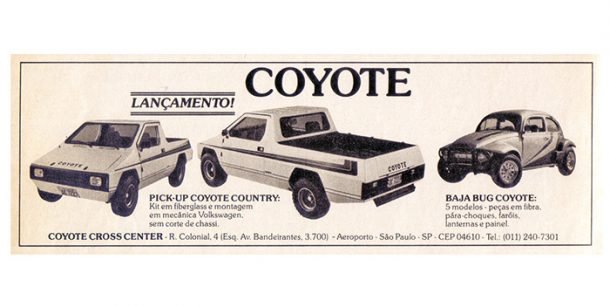 Not long ago, Rare Rides featured the Gurgel XEF, a Brazilian microcar of luxurious intent that was styled like a contemporary Mercedes-Benz, and based on a Volkswagen. Today’s Rare Ride is a very different Brazilian take on the same basic bones.
Not long ago, Rare Rides featured the Gurgel XEF, a Brazilian microcar of luxurious intent that was styled like a contemporary Mercedes-Benz, and based on a Volkswagen. Today’s Rare Ride is a very different Brazilian take on the same basic bones. Renha previously designed some buggies and cars for other Brazilian firms and decided to found his own car company in 1977. The firm’s original product was a trike with a Volkswagen engine. The initial iteration of the trike faced legislative hurdles, as it occupied a vehicle class not yet recognized by the Brazilian government. Renha revised the trike after its initial debut and added more power and different bodywork, and was able to get it past legalization. It was sold as a kit or a complete bike.
Renha previously designed some buggies and cars for other Brazilian firms and decided to found his own car company in 1977. The firm’s original product was a trike with a Volkswagen engine. The initial iteration of the trike faced legislative hurdles, as it occupied a vehicle class not yet recognized by the Brazilian government. Renha revised the trike after its initial debut and added more power and different bodywork, and was able to get it past legalization. It was sold as a kit or a complete bike.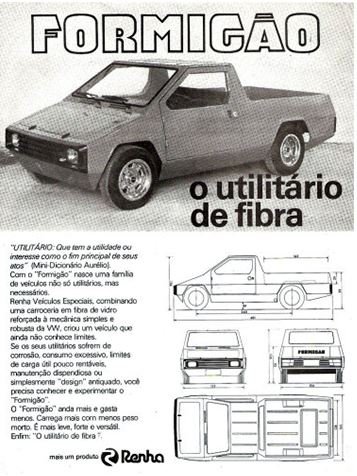 The next year Renha had more ambitious ideas and launched the Formigão. The very small pickup truck body was attached directly to a Volkswagen Beetle chassis. It used a 1.6-liter gas/ethanol engine. Renha created his own body but made no mechanical changes underneath.
The next year Renha had more ambitious ideas and launched the Formigão. The very small pickup truck body was attached directly to a Volkswagen Beetle chassis. It used a 1.6-liter gas/ethanol engine. Renha created his own body but made no mechanical changes underneath.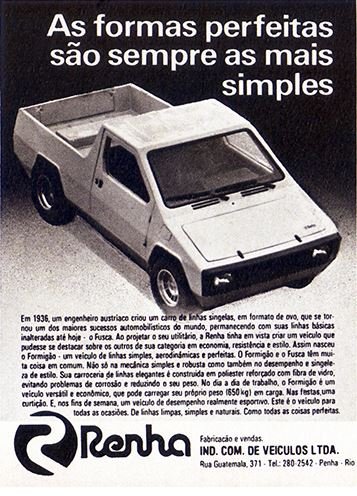 The bed capacity was not as utilitarian as one would hope, however. Volkswagen would not supply the flat design 1.6 from its second-generation Bus to outside companies, so Renha had to make do with the Beetle’s engine in its truck. As a result, there was a pronounced rectangular elevation in the bed.
The bed capacity was not as utilitarian as one would hope, however. Volkswagen would not supply the flat design 1.6 from its second-generation Bus to outside companies, so Renha had to make do with the Beetle’s engine in its truck. As a result, there was a pronounced rectangular elevation in the bed.
